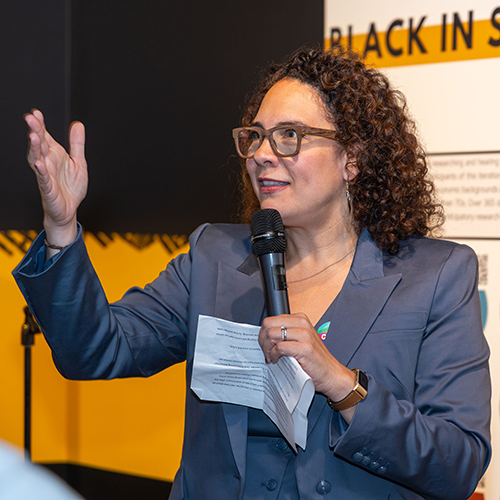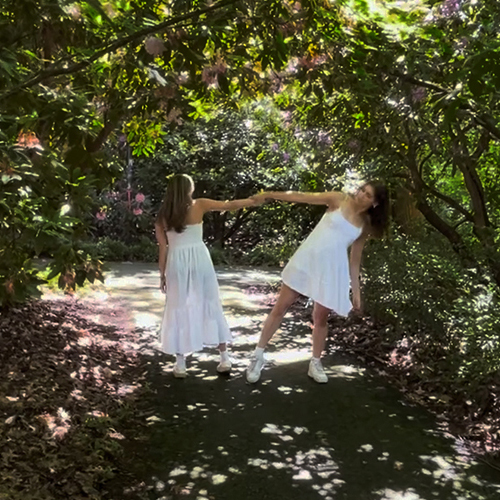“It’s okay. You can pick up the bone. See if you can guess how old it is.”
Kevin Trottier, squatting to be at kid height, is encouraging a young girl to examine a seal bone dating back thousands of years.

The bone is part of an interactive display that Trottier and other UW students
created for the Burke Museum (the Washington State Museum of Natural History and Culture, located at the UW) as part of a new course, Burke 101.
Taught by a different Burke curator each quarter, Burke 101—funded by the Lucky Seven Foundation—introduces students to hidden treasures in the museum’s collection and then challenges the students to share what they’ve learned through engaging and educational activities for museum visitors. Students spend four hours each weekend at the museum, overseeing the activities they design in class.
“We wanted to get students into the galleries, talking about the collection,” says Liz Nesbitt, curator of invertebrate paleontology and micropaleontology and associate professor of earth and space sciences. “I’ve been pushing for this for a long time.” Nesbitt taught the course during winter quarter, focusing on fossils and minerals. Curators Jim Kenagy and Peter Lape each taught one quarter, covering mammals and archaeology respectively. Graduate student Larkin Hood has served as coordinator all three quarters.
“The students’ commitment has really impressed me,” says Hood, who has been on hand each weekend to assist as needed. “We enroll any student who is interested, regardless of expertise in the subject material. We figure students can learn what they need to know to make the material come alive.”

The greatest challenge isn’t learning about the collection, says Hood. It is figuring out how to share that information with the Burke’s broad audience. “The audience might be a two-year-old or a 100-year-old,” she says. “Students have to find a way to interest a wide range of museum visitors. They have to figure out how to pitch the material depending on the audience at a given moment. That takes thinking outside yourself.”
Through Burke 101, students have designed mock excavations that have visitors digging for artifacts and analyzing them. They have planned games that involve matching a fossil with its modern-day equivalent. They have had visitors compare mastodon and mammoth teeth and postulate what the differences between the two might suggest about the animals’ diets.
After each weekend activity, students return to class on Monday for a postmortem. “In class they talk about what worked, what didn’t work as well, and what they could do to make it work better,” says Hood. “Students learn that while you might be thinking of subject material one way as a scholar, the public comes in looking at it a different way, asking different questions.” Most activities run for two weekends, giving students an opportunity to make improvements before developing their next activity.
Amy Tice, a double major in anthro-pology and earth and space sciences, remembers turning in gallery notes each week when she took Burke 101 during winter quarter. The notes would include the age range of visitors, how long they spent at an activity, and the kinds of questions they asked. Tice quickly noticed some patterns.
“Kids wanted to do activities, but adults—especially older adults—wanted to talk more, to relate what they were seeing to their own life. When we brought out the fossils, kids were excited just to get to touch stuff in a museum. For adults, the exciting part was to realize how old the fossil was. It was interesting to think about how different people learn, and to try to come up with activities that appealed to both kids and adults.”

Tice is considering a museum-related career and signed up for Burke 101 to learn more about it. She also welcomed the opportunity to study with Nesbitt, from whom she’d taken other classes. “The course didn’t count toward my major, and I was at the point where I really didn’t have time for it,” she says with a laugh, “but I felt that it was definitely worth taking anyway.”
For Tice, the biggest unknown was interacting with children. “I hadn’t worked with kids before, so that was the scary part,” she recalls. That feeling was common among students. Hood admits finding it “almost painful to watch” students the first time they interact with visitors because many of the students seem so nervous. “But they become more comfortable and some of them discover that they’ve really got it,” says Hood.
That was certainly true for Tice, who discovered, to her surprise, that she truly enjoyed teaching. “I never really thought about teaching, but after this experience the idea is more intriguing to me,” she says. “I learned that you can adjust what you’re saying based on a person’s body language. You can sense whether they‘re getting it. A lot of it is about reading people. And the feeling when something clicks for them— it feels really good.”

Nesbitt had the same feeling as she watched the UW students click during Burke 101. Students who were tentative at the beginning of the quarter became increasingly confident and self-directed. “They grew so much, from unsure and unfocused students to people who could now teach the class,” says Nesbitt. “There was a huge difference from the first week to the last. The learning curve was gigantic.”
And what happens to students after completing the course? Most say their attachment to the Burke Museum will continue. Hood recalls one student commenting that he had lived across from the Burke for two years and had never come in before taking the class. He wrote in his course evaluation, “Now I’ll keep coming, and I’ll encourage my friends to come. I know that I’m welcome here.”
Tice has found that she really misses those weekend shifts in the museum. “I hope that next year I can volunteer at the Burke,” she says, “because I just love it there.”
More Stories

Democracy by the Numbers
Mathematics and Democracy, an undergraduate mathematics course, explores the role of math in many aspects of democracy, from elections to proportional representation.

Interrupting Privilege Starts with Listening
Personal stories are integral to Interrupting Privilege, a UW program that leans into difficult intergenerational discussions about race and privilege.

Dancing Across Campus
For the dance course "Activating Space," students danced in public spaces across the University of Washington's Seattle campus this spring.